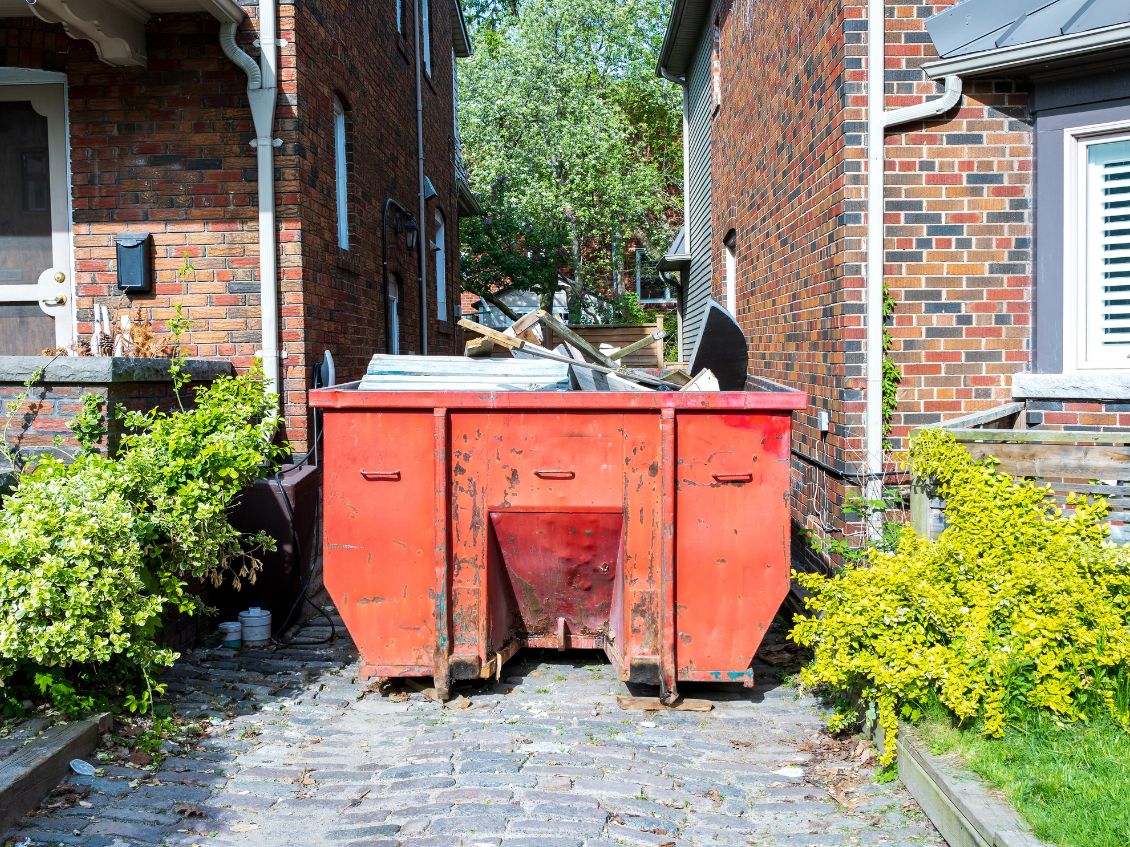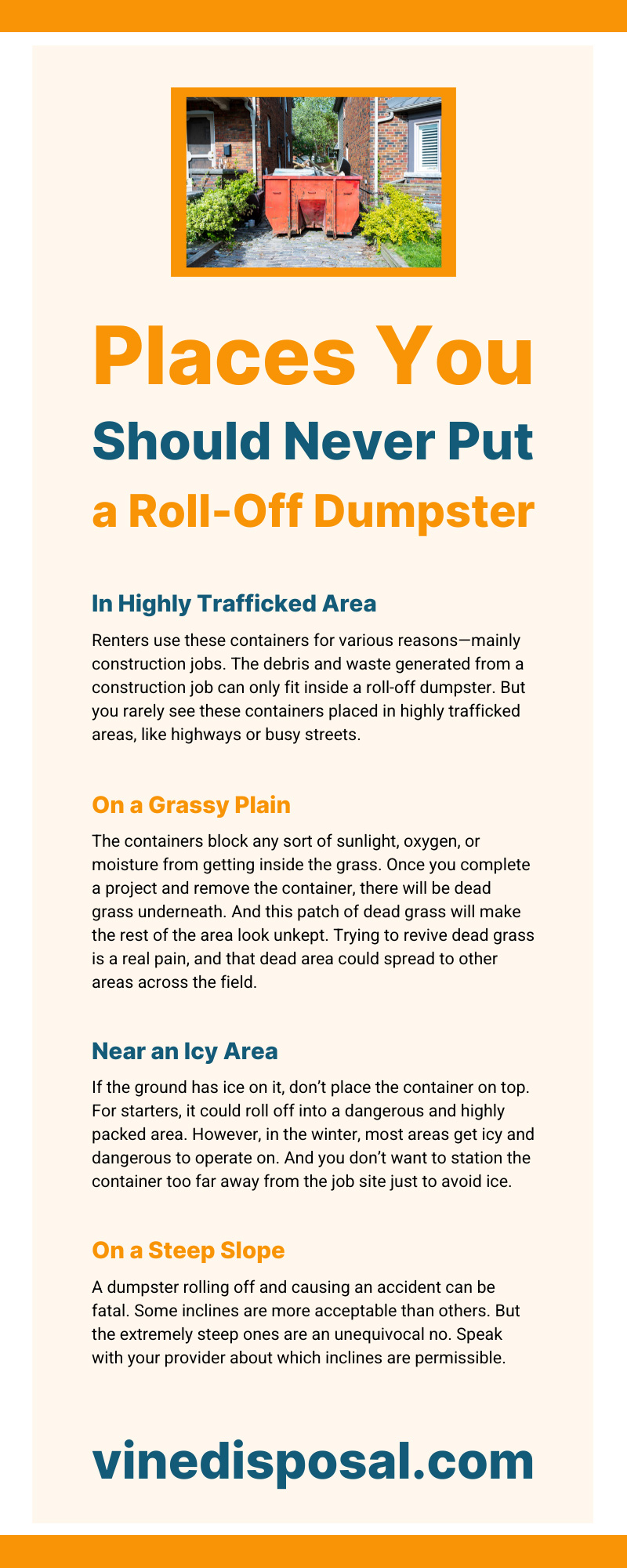
The rules for roll-off dumpsters are vast. Renters need to know what they can place inside the containers, how long they can rent the containers for, how to maintain the containers, and where to station them. It’s a long list to keep up with, but we’re here to keep our customers informed. Let’s start off with the seven places you should never put a roll-off dumpster.
In Highly Trafficked Area
Think about the places where you commonly see roll-off dumpsters. Are those locations fairly low-key? There’s a reason behind that. Renters use these containers for various reasons—mainly construction jobs. The debris and waste generated from a construction job can only fit inside a roll-off dumpster.
But you rarely see these containers placed in highly trafficked areas, like highways or busy streets. The level of disruption and amount of traffic these containers generate will cause too much trouble in these areas. Try and refrain from placing these containers in overly crowded areas. And never place them on highways.
These containers need a section where they can take up space, and highways don’t offer much real estate for roll-off dumpsters. Conducting construction in a busy area is sometimes unavoidable. When that happens, try and block off as much space as possible without overtly disrupting the flow of traffic.
On a Grassy Plain
Grass and roll-off dumpsters just don’t mix. They may seem like a good match, but take our word for it—they aren’t. The weight of the dumpster is too heavy to station on top of a field. This isn’t to say the field can’t hold the weight. It can, but it will damage the grass.
The containers block any sort of sunlight, oxygen, or moisture from getting inside the grass. Once you complete a project and remove the container, there will be dead grass underneath. And this patch of dead grass will make the rest of the area look unkept. Trying to revive dead grass is a real pain, and that dead area could spread to other areas across the field.
Plus, grass can get unstable at times. When the ground gets wet and soaked, the container will start to sink lower. A dumpster stuck in mud is terrible for all parties involved. Transporting and cleaning it only gets more difficult. So always keep the roll-off dumpster stationed on concrete.
Near an Icy Area
If the ground has ice on it, don’t place the container on top. For starters, it could roll off into a dangerous and highly packed area. However, in the winter, most areas get icy and dangerous to operate on. And you don’t want to station the container too far away from the job site just to avoid ice.
Lay down a hefty amount of salt or sand before placing the dumpster down. It’s important to melt as much ice as possible before getting to work. You’ll need to constantly salt the perimeter throughout the season, especially when snowstorms take place.
Shovel snow away from the container. You don’t want to create a barrier or blockage with the snow because that will make it more difficult to transport the dumpster when it’s time for pick up. There needs to be space where the truck can easily maneuver around the dumpster for proper disposal.
On a Steep Slope
Yes, dumpsters are pretty stationary. And yes, there is a lock on the wheels. However, that doesn’t mean you should test fate. Technically, you can place a roll-off dumpster on a slope, incline, or heel. But if you can avoid this as an option, we suggest you do.
A dumpster rolling off and causing an accident can be fatal. Some inclines are more acceptable than others. But the extremely steep ones are an unequivocal no. Speak with your provider about which inclines are permissible.
They can give you an exact measurement and an image to compare your incline with. Go with whatever their recommended number is. If they see a potential problem, they will recommend a solution to combat it. For example, you could possibly lay down a barrier or place something underneath the container to stabilize it.
On a Damaged Surface
Most hard surfaces are sustainable for dumpsters, but there are some locations that have seen better days. If a sloping surface is already starting to crack and deteriorate, it’s best to find another spot for your dumpster.
The weight of the container and all the contents inside could cause more damage to the surface. The wheels of the roll-off dumpster might worsen the damage. If you’re not sure how much damage is too much, speak with your provider.
They can tell you the exact signs to look for to avoid any issues with the container. Plus, placing it on top of damaged property could mess with the exterior of the dumpster.
Blocking an Entrance
This seems like an obvious point to make, but it’s still worth mentioning. Never place the dumpster in front of an area that blocks an entrance—especially for crucial locations like residential properties or hospitals.
There’s always a place off to the side for the dumpster to stay put. Blocking off an entrance is a fire hazard and creates a real inconvenience for everyone who frequents that area.
Over a Sewer
You should never block sewage systems. The world needs them for a reason. Roll-off dumpsters aren’t so low to the ground that they make it impossible for things to travel underneath, but nothing’s perfect. It’s possible that a wheel could snap off, and the container could drop lower than expected.
When it rains, the water needs to reach the sewer without any problems. If there’s something blocking the pathway, a flood could occur in the area, and that’s a serious situation. Station the 10-yard dumpster near the sewer but never directly above it.
At Vine Disposal, we like helping our customers know all the dos and don’ts when it comes to roll-off dumpsters. Telling the places you should never place them is only a small portion of what we know. For more information, visit our website.

